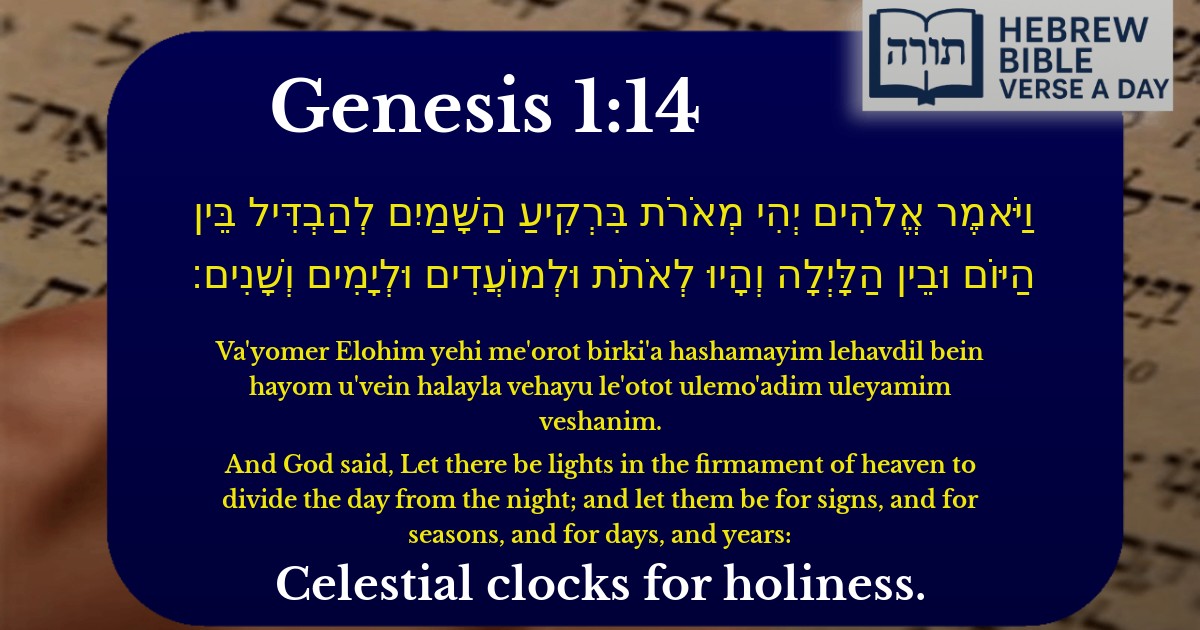Join Our Newsletter To Be Informed When New Videos Are Posted
Join the thousands of fellow Studends who rely on our videos to learn how to read the bible in Hebrew for free!
Hebrew Text
וַיֹּאמֶר אֱלֹהִים יְהִי מְאֹרֹת בִּרְקִיעַ הַשָּׁמַיִם לְהַבְדִּיל בֵּין הַיּוֹם וּבֵין הַלָּיְלָה וְהָיוּ לְאֹתֹת וּלְמוֹעֲדִים וּלְיָמִים וְשָׁנִים׃
English Translation
And God said, Let there be lights in the firmament of heaven to divide the day from the night; and let them be for signs, and for seasons, and for days, and years:
Transliteration
Va'yomer Elohim yehi me'orot birki'a hashamayim lehavdil bein hayom u'vein halayla vehayu le'otot ulemo'adim uleyamim veshanim.
Hebrew Leining Text
וַיֹּ֣אמֶר אֱלֹהִ֗ים יְהִ֤י מְאֹרֹת֙ בִּרְקִ֣יעַ הַשָּׁמַ֔יִם לְהַבְדִּ֕יל בֵּ֥ין הַיּ֖וֹם וּבֵ֣ין הַלָּ֑יְלָה וְהָי֤וּ לְאֹתֹת֙ וּלְמ֣וֹעֲדִ֔ים וּלְיָמִ֖ים וְשָׁנִֽים׃
Parasha Commentary
📚 Talmud Citations
This verse is quoted in the Talmud.
📖 Chullin 60b
The verse is discussed in the context of the creation of the sun and moon, and their roles in distinguishing between day and night, as well as their use for signs and seasons.
📖 Rosh Hashanah 8a
The verse is referenced in a discussion about the calculation of the new year and the importance of the celestial bodies in determining the calendar.


The Purpose of the Heavenly Lights
In this verse (Bereishit 1:14), Hashem commands the creation of the celestial bodies—the sun, moon, and stars—to serve multiple purposes in the world. Rashi explains that these lights were created not merely for illumination, but to fulfill specific divine functions:
The Midrashic Perspective
The Midrash (Bereishit Rabbah 6:1) elaborates that the sun and moon were initially created equal in brightness, but the moon was diminished after protesting, "Two kings cannot share one crown." This teaches humility and the importance of accepting Hashem’s decree. Additionally, the Midrash highlights that the lights were created on the fourth day to demonstrate that they are not deities—contrary to pagan beliefs—but creations subordinate to Hashem’s will.
Halachic Implications
Rambam (Hilchot Kiddush HaChodesh 1:1) emphasizes that the Jewish calendar is based on lunar cycles, as derived from this verse. The moon’s phases determine the months, while the sun regulates the seasonal years, ensuring that Pesach always falls in spring (as per Vayikra 23:4). This dual system reflects the harmony between celestial bodies in fulfilling their divine roles.